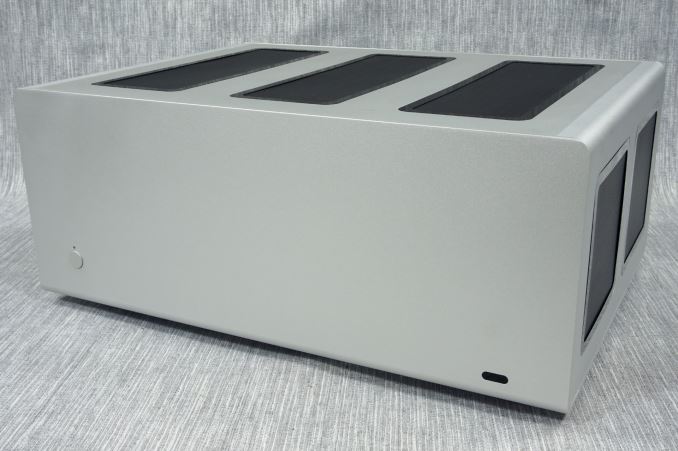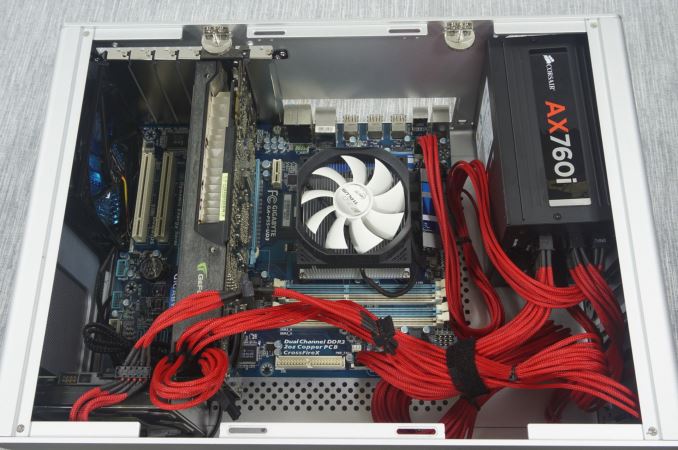The Streacom F12C Aluminum Desktop Case Review
by E. Fylladitakis on September 14, 2015 9:00 AM ESTConclusion
The F12C is Streacom's first attempt to stray away from SFF and passively cooled cases, towards the territory of high performance enclosures for advanced PCs. As a company, Streacom has a fair share of experience with aluminum enclosures and the F12C reflects that. It is an exquisitely shaped and finished case, without a single visible flaw. Aesthetics are a subjective matter but we believe that few would not appreciate the elegant simplicity of pure aluminum. Despite its many openings and the very low weight, the mechanical strength of the F12C is remarkable. Its surface is also strongly resistant to fingerprints, stains and scratches, which is very important if the case will be installed in a living room with children or pets roaming about.
A very important feature of the Streacom F12C is the modular internal configuration design. The multipurpose mounting bars attached to rails is an excellent idea that allows unforeseen levels of customization. If we were talking about a large tower case, having such rails across its main panels would result to infinite possible configurations. For the F12C in particular, it definitely is very effective but imperfectly applied. If there is an ATX motherboard in the case, the left side panel rail becomes almost useless, as even a fan will block the motherboard's headers. If the case was just an inch wider, fans or drives could be installed on the left side panel without compatibility issues with ATX motherboards. The 450 mm standard width limit of AV cabinets is what obviously limited Streacom and they wanted to make sure that their design would fit inside all common furniture. This makes the F12C a little too narrow for systems with ATX motherboards, forcing the user to either abandon most of the left rail or select a shorter motherboard instead. Still, if a mATX or ITX motherboard is selected, there is more than plenty of space for radiators, fans, and drives, offering the user some flexibility when choosing components. Finally, the locking mechanism could have been a lot better than a metallic clip.
Despite its very high quality and versatile design, there are two issues with the F12C chassis that may affect users. The first is the omission of any front I/O ports. Getting rid of the 3.5 mm headphone jacks could be justified somehow, but having no front (or side) USB ports limits the usability in a HTPC environment, requiring users to solely use the IR remote route. This is especially true for a case intended for HTPC systems that also offers no option for an optical drive at all. Even if we consider a household that every main storage device is accessible via the network, being unable to attach a simple flash drive or HDD is problematic. The second aspect is of the retail price. The case is not available yet for the North American markets, but a retail price of about $225 (currently 199 EUR in Germany, 166 GBP in the UK) is very steep and definitely not for those with a tight budget. Streacom's pricing means that the case is aimed more at a premium crowd, which certainly highlights the aluminium chassis and lightweight, modular design, but it will be elimated from the non-premium crowd based on price almost immediately.
Streacom designed and produced the F12C chassis obviously hoping to gain a piece of the market consisting of users who want to build very powerful HTPC systems, usually designed to double as gaming machines. Actually, the design and capabilities of the F12C chassis have it leaning more towards gaming machines rather than HTPC systems, limiting the market potential of the case even further. The F12C is aimed towards an admittedly small fraction of the PC market, aimed to users who will not consider the cost too much. The modular mounting system requires a little bit of extra work with a screwdriver, but it offers excellent versatility to those that want to build their own unique designs. However, these users also are very demanding and the F12C has a shortcomings as well. The lack of front USB ports and the inability to use any type of optical media are important issues for HTPC users, but we could imagine that a system integrator might take this chassis and attempt to build a custom machine.












45 Comments
View All Comments
techxx - Monday, September 14, 2015 - link
Who in the world needs full-sized ATX nowadays? Case looks great, but too big.DanNeely - Monday, September 14, 2015 - link
Anyone doing 2-way SLI/XFire will benefit from being able to space the cards out without crowding the CPU socket by having the 1st GPU in the top PCIe slot.DanNeely - Monday, September 14, 2015 - link
That said, I'm not sure why you'd want to for an HTPC though; and this case seems to've added it as a feature check instead of as a practical option anyway.hpascoa - Monday, September 14, 2015 - link
Replace "HTPC" with "Steam Machine" and it starts making a whole lot more sense.DanNeely - Monday, September 14, 2015 - link
Not really. 4k is mostly pointless at TV viewing distances and a single GPU is more than plenty at 1080p.Bully242 - Friday, September 18, 2015 - link
So is 720p if you sit back far enough.. Don't see how your opinion makes 4k pointlessWwhat - Wednesday, September 23, 2015 - link
Soon a slew of VR headsets will ht the market.Although a card like the fuji nano should do OK in a single card setup even for the larger resolution that requires.
jardows2 - Monday, September 14, 2015 - link
The size of the case does not bother me, as there a mATX cases that are as large in overall volume. This gives options for many hard drives or fans. The real question is why anyone would need a full ATX motherboard, unless they are using 3-way SLI or crossfire.joex4444 - Monday, September 14, 2015 - link
I have a full ATX motherboard that's well populated. GPU taking up two slots, a WiFi PCIe card, a TV tuner PCIe card, a USB 3.0 PCIe card (LGA775 - onboard USB2.0 only), and a PCIe 8 port external SAS RAID card.jardows2 - Tuesday, September 15, 2015 - link
Forgot about the TV Tuner. For an HTPC, that is a big consideration.